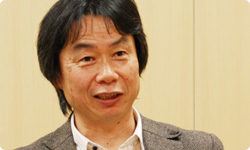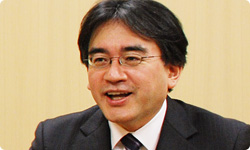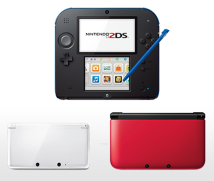1. Nintendo 3DS Built-in Software
Editor’s note: This volume has been conducted to mark the Japanese release of Nintendo 3DS, which is on 26 February 2011. The European release date is 25 March 2011.
Today I’d like to ask Miyamoto-san a few things before the Nintendo 3DS system is released.
Sure.
The first question is on the title Steel Diver.1 I believe you’re working on it hands-on. 1Steel Diver: A submarine combat game featuring three modes: side-scrolling action, periscope action and strategy simulation. Under development for the Nintendo 3DS system and scheduled for release on March 25, 2011 in Europe.
Yes.
The gameplay consists of “slowly moving a submarine.” For the lack of a better word, this game is very “plain.”
I guess so. (laughs)
One question is what made you want to create this game for the Nintendo 3DS system now? Another is, why did you decide to remake The Legend of Zelda: Ocarina of Time2 and Star Fox 643 for the Nintendo 3DS system? 2The Legend of Zelda: Ocarina of Time: An action-adventure game first released for the Nintendo 64 system in November 1998 in Japan. A remake, entitled The Legend of Zelda: Ocarina of Time 3D, is scheduled for release on the Nintendo 3DS system. 3Star Fox 64: A 3D shooting game first released for the Nintendo 64 system in April 1997 in Japan. A remake, entitled Star Fox 64 3D, is scheduled for release on the Nintendo 3DS system.
Uh-huh.
And finally, I have a question in regard to the Nintendo 3DS built-in software. There is quite a range of software included on the hardware this time around. What made you decide to add so much?
All right. So where should I start?
Well, why don’t we start with the games that will be released soonest?
Then let’s go with the built-in software first.

The Nintendo 3DS system has AR Games (Augmented Reality games), Face Raiders, StreetPass Mii Plaza and much, much more. In other words, just having the Nintendo 3DS system will allow you to play a variety of games.
Right.
In Nintendo’s past history, (Hiroshi) Yamauchi-san has said, “The hardware is just a box you buy because you want to play games that run on it.” Those were his exact words. (laughs)
I remember that! (laughs)
Though the way he said it may be a bit rough around the edges, it was a very easy-to-understand explanation of the business model at the time.
Yes.
And beyond that period, when the Nintendo DS system was released you had PictoChat4 built-in on the hardware for the very first time. The Wii console also had various other built-in features added, while the Nintendo DSi system even had cameras and sound. And this time, for the Nintendo 3DS system, it will have a variety of built-in software. What were your intentions when you decided to do this? 4PictoChat: A built-in software programme on the Nintendo DS system; words and drawings can be exchanged among as many as 16 Nintendo DS units.
Well, basically speaking, over half of the built-in software was not planned by me from the beginning. Many people within the company suggested and researched many things, which made it happen in its current form.
Oh, right. For example, in AR Games, you can add various objects to the real scenery seen through the camera. This will allow you to mix the virtual world with reality. And this is something members of the Entertainment Analysis & Development Department (EAD) have been working on for some time.
Yes. It started off like their science fair project, but there wasn't any specific hardware they could run it on. (laughs)
And when you first saw it, you knew it would be a great idea for a new game?
No, I didn’t! At the time, I said, “We can’t use that kind of stuff as a new game.” (laughs)
(laughs)
I said something like, “You can’t let trends decide what you do.”
(laughs) You are very strict on not following current trends.
But as the basic features of the Nintendo 3DS system started to become fixed, all the ideas from here and there started to make a lot more sense.
You’re exactly right about that.
Once we decided on making it 3D, it all happened very quickly. Suggestions like “we have a camera on it, so let’s make it possible to take 3D photos” started to be made one after another. Even the projects I felt doubtful of in the beginning, when the prototypes were completed, we all felt very convinced that they would work.
Yes. When they took a 3D photo themselves, just looking at it on the spot made them feel very happy.
That’s right.
Of course, 3D photo-taking existed in the past, but it had never been so readily available to so many people and so easy for them to pick up and enjoy.

You don’t have to buy a special camera or use a special printing process. You can take the pictures and view their surprising results on the spot. That entire experience is fun and entertaining.
Yes. You can enjoy using the Nintendo 3DS system even just as a viewer for 3D photos.
If you just look at it that way, it’s like a very easy-to-use 3D photo frame. In that sense, I thought it would be better to keep it built into the Nintendo 3DS system so everyone would be able to use it together. I felt the same way about the AR Games, Face Raiders and Nintendo 3DS Sound. They were all included under the same philosophy.
I see.
Among the built-in software of the Nintendo 3DS system, we put the most focus on Mii integration.
Right.
